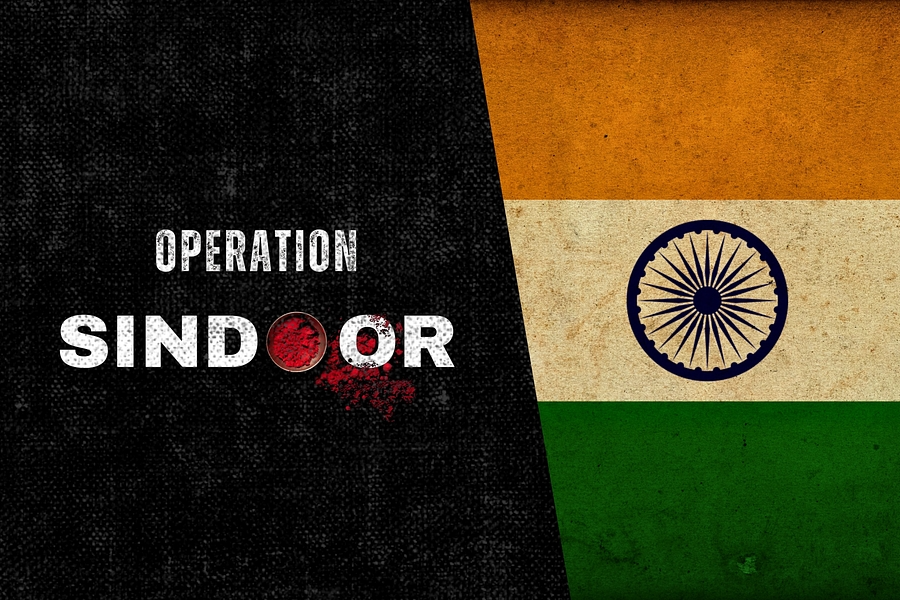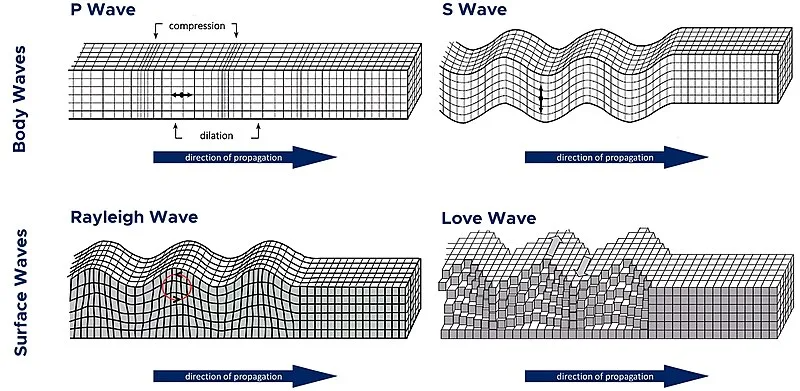September 27th Current Affairs
Table of Contents
Kannada Literature Optional Syllabus
Home / ಐಚ್ಚಿಕ ಕನ್ನಡ ಸಾಹಿತ್ಯದ ಪಠ್ಯಕ್ರಮ ಐಚ್ಚಿಕ ಕನ್ನಡ ಸಾಹಿತ್ಯ ಪತ್ರಿಕೆ – 1 ವಿಭಾಗ – ಎ ಅ) ಕನ್ನಡ ಭಾಷೆಯ ಚರಿತ್ರೆ ಭಾಷೆ
UPSC Current Affairs – October 6th
October 06th Current Affairs Home / Table of Contents 36-hour curfew imposed in parts of Odisha’s Cuttack over communal tensions
Religious Minorities in India and the Challenge of Communal Harmony: A Sociological Reflection on the Cuttack Violence
Home / Religious Minorities in India and the Challenge of Communal Harmony: A Sociological Reflection on the Cuttack Violence Sociology
UPSC Current Affairs – October 4th
October 04th Current Affairs Home / Table of Contents Isabgol Processors threaten to halt purchases from October 6th over GST
Sologamy and Contemporary Trends in Marriage: A Sociological Perspective
Home / Sologamy and Contemporary Trends in Marriage: A Sociological Perspective Sociology Paper 1: Systems of Kinship – Contemporary trends
UPSC Current Affairs – October 3rd
October 03rd Current Affairs Home / Table of Contents NASA IMAP to show how solar particles are energised and shield
Understanding Indian Festivals through Durkheim: Religion, Rituals, and Collective Conscience
Home / Understanding Indian Festivals through Durkheim: Religion, Rituals, and Collective Conscience Sociology Paper 1: Émile Durkheim – Religion and
UPSC Current Affairs – September 30th
September 30th Current Affairs Home / Table of Contents Ladakh groups reject talks with government, Ministry says open to dialogue
Caste Census in India: A Sociological Perspective
Home / Caste Census in India: A Sociological Perspective Sociology Paper 2: Caste System – Features of Caste system. The
Constitutional Morality: Upholding India’s Democratic Ethos
Home / Constitutional Morality: Upholding India’s Democratic Ethos Sociology Paper 2: Visions of Social Change in India – Constitution, law,
'Absurd Display Of Theatrics': India Slams Pakistan PM For Glorifying Terrorism At UNGA

Relevance to UPSC
GS Paper II: International Relations
- Illustrates how India uses multilateral forums (UNGA) to present its position and counter its narratives.
- Shows diplomatic strategy, soft power, and strategic communication in India-Pakistan relations.
- Highlights the role of terrorism and cross-border security as central issues in India’s foreign policy.
GS Paper III: Internal Security & Terrorism
- Links to terrorism, cross-border threats and state sponsorship in such activities.
- Reflects interlinkage between defence, foreign policy, and diplomacy in addressing non-traditional threats.
More About the News
- India strongly rebuked Pakistan’s Prime Minister Shehbaz Sharif at the UNGA, calling his speech “absurd theatrics” and accusing him of glorifying terrorism.
- The Indian delegation’s reply stated that no level of drama can conceal facts, and pointed to Pakistan’s history of sheltering terrorist organisations.
- India demanded that Pakistan dismantle its terrorist infrastructure and hand over terrorists wanted in India.
United Nations General Assembly (UNGA)
The United Nations General Assembly (UNGA), established in 1945, is the UN’s chief deliberative and representative organ with 193 member states. It provides a global forum for cooperation, dialogue, and consensus on critical international issues. In a world of shifting power balances, UNGA’s role in strengthening multilateralism and global governance is more vital than ever.
Evolution
- Created in 1945 under the UN Charter as the main decision-making body.
- First session convened in London, 1946 with 51 members.
- Expanded over time as decolonisation increased membership to 193 today.
Structure
- All 193 members have equal voting rights (one nation, one vote).
- Presided over by a President of the General Assembly (PGA) elected annually.
- 6 Main Committees: Disarmament, Economic & Financial, Social/Humanitarian, Special Political/ Decolonization, Administrative/Budgetary, Legal.
- Decisions: Simple majority, or two-thirds majority for key issues (peace, security, budget, membership).
Functions and Powers
- Discusses international peace, security, development, and cooperation.
- Elects non-permanent UNSC members, ECOSOC members, and judges of the ICJ.
- Appoints the UN Secretary-General on the recommendation of the UNSC.
- Adopts the UN budget and oversees administrative functioning.
- Issues non-binding resolutions, but they hold strong moral and political weight.
Role in Maintaining Global Peace and Order
- Created the Uniting for Peace Resolution (1950) enabling GA to act when UNSC is deadlocked.
- Facilitates dialogue on disarmament and nuclear non-proliferation.
- Provides a platform for peaceful dispute resolution through diplomacy.
- Mobilises humanitarian responses in crises (e.g., refugee issues, pandemics).
Achievements
- Adopted the Universal Declaration of Human Rights (1948).
- Championed decolonisation (1960s), granting legitimacy to new nations.
- Created Sustainable Development Goals (SDGs) framework.
- Played a role in apartheid condemnation and the recognition of Palestinian rights.
- Facilitated consensus on climate action and disarmament initiatives.
Challenges
- Resolutions are non-binding, limiting enforceability.
- The dominance of the UNSC reduces the GA’s power in peace and security.
- Polarisation among the developed vs developing countries.
- Lack of resources compared to ambitious global mandates.
- Struggles in addressing new-age challenges like cyber warfare, AI, global terrorism.
Reforms Needed
- Strengthen enforcement mechanisms for GA resolutions.
- Increase role in peacekeeping mandates.
- Democratise UN decision-making to balance UNSC dominance.
- Enhance GA’s capacity to deal with global commons (climate, cyberspace, oceans).
- Ensure inclusivity for Global South concerns.
India & UNGA
- Founding member, active participant in peacekeeping and multilateral initiatives.
- Uses UNGA to highlight issues like terrorism, climate justice, and development finance.
- Advocates for UN reforms, including expansion of UNSC.
- Voices concerns of developing nations under South-South cooperation.
- India’s election as a non-permanent UNSC member is often influenced through GA diplomacy.
The UNGA reflects the collective conscience of humanity, though limited in enforcement powers. As global challenges transcend borders, strengthening the UNGA is crucial for equitable and effective multilateralism. Its future lies in bridging global divides and shaping a rules-based order.
Prelims MCQ
Q. With reference to the United Nations General Assembly, consider the following statements: 1. The UNGA can grant observer status to non-member states. 2. Intergovernmental organisations can seek observer status in UNGA. 3. Permanent Observers in UNGA can maintain missions at the UN headquarters. Which of the above statements are correct?
A. 1 and 2 only
B. 3 only
C. 1 and 3 only
D. All of the above
Mains Question
Q. The United Nations General Assembly, despite being the most democratic global forum, faces structural and functional challenges that limit its role in maintaining peace and order. Discuss with reference to India’s engagement with UNGA.
PM Modi to launch Swadeshi 4G network today
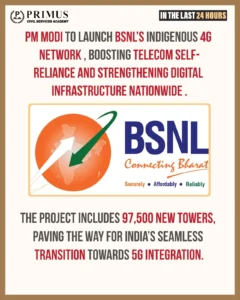
Relevance to UPSC
GS Paper II: Governance
- Demonstrates how government policy is promoting technological self-reliance (Atmanirbhar Bharat) in strategic sectors like telecom.
- Highlights the role of public sector enterprises (like BSNL) in executing national infrastructure goals.
- Relates to policy aspects of digital inclusion, connectivity and bridging the urban-rural digital divide.
GS Paper III: Science & Technology, Economy, Infrastructure
- Involves telecommunications infrastructure, a key pillar of modern digital economy and growth.
- Emphasizes the indigenisation of telecom equipment as a step to reduce import dependence and build India’s manufacturing capacity.
- Connects with future technologies (5G/6G upgradability) and India’s global competitiveness in tech.
More About the News
- PM Narendra Modi is set to inaugurate BSNL’s indigenous “Swadeshi 4G” network, developed fully in India, along with 97,500 4G towers.
- The swadeshi 4G stack is designed to be upgradeable to 5G and reduce dependence on foreign telecom equipment.
- The project also includes a “4G Saturation” effort to extend connectivity to remote and uncovered villages across India.
2G, 3G, 4G & 5G Technologies
Mobile communication technologies have evolved rapidly from 2G to 5G, transforming global connectivity, economic growth, and digital innovation. Each generation has brought higher data speeds, reduced latency, and enabled new applications across sectors. The ongoing 5G rollout in India promises to revolutionize industries, governance, and citizen services, shaping the country’s digital future.
Evolution of Mobile Communication Technologies
- 2G (1990s): Introduced digital voice services, SMS, and basic data.
- 3G (2000s): Enabled mobile internet, video calling, and multimedia messaging.
- 4G (2010s): High-speed mobile broadband, VoLTE, HD video streaming, IoT applications.
- 5G (2020s): Ultra-low latency, massive IoT connectivity, smart cities, autonomous vehicles, industrial automation.
Comparison Table: Features, Advantages, Disadvantages, Applications
Technology | Features | Advantages | Disadvantages | Applications |
2G | Digital voice, SMS, limited data | Low cost, widespread coverage | Low data speed, limited multimedia | Basic calls, SMS, MMS |
3G | Mobile internet, video calling | Higher data speed, mobile browsing | High cost, limited coverage initially | Video calls, mobile internet, online banking |
4G | High-speed broadband, VoLTE | High-speed internet, HD streaming, IoT support | Requires 4G-enabled devices, limited rural reach | Streaming, e-commerce, IoT, smart apps |
5G | Ultra-low latency, massive IoT, network slicing | High-speed, real-time communication, smart cities | Infrastructure cost, spectrum allocation issues | AI, autonomous vehicles, telemedicine, AR/VR, smart grids |
Government Initiatives
- 5G Test Beds & Pilot Projects: Deployment of 5G test sites in IITs and urban clusters.
- BharatNet Project: Expanding high-speed internet to rural areas, supporting 4G/5G adoption.
- Spectrum Auctions: Regular auctions to enable private telecom operators to roll out 5G.
- Make in India for Telecom: Encouraging indigenous production of network equipment.
Prelims MCQ
Q. Consider the following statements regarding 5G technology: 1. 5G offers ultra-low latency enabling real-time applications. 2. 5G is backward compatible with 2G and 3G networks. 3. 5G enables network slicing for customized services. Which of the statements given above is/are correct?
A. 1 and 2 only
B. 2 and 3 only
C. 1 and 3 only
D. All of the above
Mains Question
Q. The evolution from 2G to 5G has transformed communication, commerce, and governance in India. Examine the benefits, challenges, and policy measures needed to ensure effective 5G deployment in India.
Union Minister Shivraj Singh Chouhan Releases the 21st Instalment of PM-KISAN Scheme Today
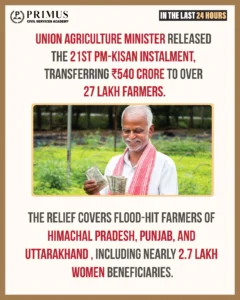
Relevance to UPSC
GS Paper II: Governance & Welfare Schemes
- Demonstrates how central welfare schemes are administered and funds disbursed via Direct Benefit Transfer (DBT).
- Shows the role of government in disaster response via policy levers to support vulnerable agrarian communities.
- Highlights challenges in targeting, inclusion, and timely delivery of benefits to farmers in distress.
GS Paper III: Agriculture, Rural Development, Sustainable Growth
- Links to income support and minimum support for farmers, a pillar of agrarian economy stability.
- Reflects fiscal commitment and budgetary priorities in agriculture and rural welfare.
- Emphasizes the resilience and recovery of agriculture following shocks (floods, landslides) via state support mechanisms.
More About the News
- Union Minister Shivraj Singh Chouhan released the 21st instalment of the PM-Kisan scheme via video conference for farmers.
- Over ₹540 crore was transferred to more than 27 lakh farmers in flood-affected states like Punjab, Himachal Pradesh, and Uttarakhand.
- The funds aim to assist farmers in meeting immediate needs, buying inputs and resuming cultivation after natural calamities.
Pradhan Mantri Kisan Samman Nidhi (PM-KISAN)
The Pradhan Mantri Kisan Samman Nidhi (PM-KISAN) scheme, launched in 2019, provides direct income support to small and marginal farmers in India. It exemplifies targeted welfare through Direct Benefit Transfer (DBT), reducing leakage and ensuring timely assistance. Strengthening rural livelihoods through such schemes is essential for sustainable agrarian development and inclusive growth.
Features of PM-KISAN
- Provides ₹6,000 per year per farmer, paid in three equal installments.
- Direct Benefit Transfer (DBT) to th eeligible farmer’s bank account.
- Covers small and marginal farmers initially, later extended to all farmer families owning cultivable land.
- Aims to supplement income for agricultural and allied activities.
- Administered jointly by Central and State Governments for verification and implementation.
Inspiration for the Scheme
The PM-KISAN Scheme was inspired from the Telangana Government scheme called “Rythu Bandu”
Administration of the Scheme
The scheme is a central Sector Scheme and the Nodal Ministry is the Ministry of Agriculture and Farmer’s Welfare.
Objectives of the Scheme
- Provide income support to farmers to meet agricultural and household expenses.
- Reduce farmer distress and indebtedness.
- Promote financial inclusion through DBT.
- Encourage modern farming practices and investment in agriculture.
- Ensure equity among small and marginal farmers.
Eligibility Criteria
- Farmer’s family with cultivable land ownership.
- Excludes institutional landholders, high-income taxpayers, and professionals such as doctors, engineers, and government officials.
- Must be Indian citizens.
- Beneficiaries must be registered through State /UT governments for verification.
Need for PM-KISAN
- Low farmer income: Small and marginal farmers often earn below subsistence; PM-KISAN supplements income.
- Crop failure & natural disasters: Provides a financial buffer during floods, droughts, or pest attacks.
- High debt burden: Reduces dependence on informal moneylenders, e.g., Andhra Pradesh saw DBT reduce farmer loans.
- Support for allied activities: Encourages adoption of fertilizers, seeds, and irrigation tools.
- Enhance rural consumption: Strengthens rural economy, increases purchasing power, e.g., increased local demand for farm inputs.
Impacts of PM-KISAN
- Timely income support: Helps farmers purchase inputs, reducing crop losses.
- Financial inclusion: Bank account linkage ensures participation in formal financial systems.
- Reduced rural distress: Alleviates distress migration and reduces suicides in agrarian states.
- Boost to agricultural productivity: Extra cash allows investment in better seeds or irrigation.
- Economic multiplier effect: Increased rural demand benefits small businesses and local markets.
Challenges Faced
- Exclusion errors: Eligible farmers are sometimes left out due to incorrect land records.
- Inclusion errors: Some non-eligible families get benefits due to verification loopholes.
- Delayed transfers: DBT may be delayed due to technical or administrative issues.
- Awareness gaps: Many farmers are unaware of scheme benefits, especially in remote areas.
- Limited coverage of tenant/sharecroppers: Many landless cultivators are excluded.
Way Forward
- Expand coverage to tenant farmers and sharecroppers.
- Improve land record digitisation for accurate identification.
- Enhance awareness campaigns in rural areas.
- Integrate with other rural welfare schemes for holistic support.
- Monitor impact through data-driven evaluation for policy improvement.
Prelims MCQ
Q. Consider the following statements regarding PM-KISAN:
1. It provides ₹6,000 per year to all farmers’ families.
2. It is administered by both Central and State governments.
3. Only small and marginal farmers are eligible.
Which of the statements given above is/are correct?
A. 1 and 2 only
B. 2 only
C. 2 and 3 only
D. All of the above.
PM-KISAN provides ₹6,000 per year only to eligible farmers, not all families. It is jointly implemented by Central and State governments. Initially, it targeted small and marginal farmers, but now eligibility extends beyond them in some states.
Mains Question
Q. PM-KISAN has transformed the agrarian landscape in India, but challenges in coverage and implementation remain. Critically analyse its impact, limitations, and suggest policy measures for improvement.
Wangchuk held under NSA, flown from Leh to Jodhpur as Government cracks down
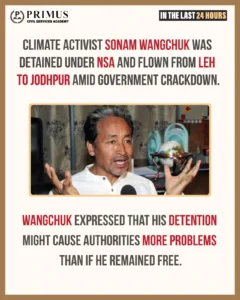
Relevance to UPSC
GS Paper II: Polity, Rights, Governance
- Highlights issues around fundamental rights (freedom of speech, assembly) and limitations under laws like the NSA.
- Illustrates tensions between state security powers and civil liberties, especially in sensitive regions like Ladakh.
- Shows how government actions (licence revocation, detention) intersect with governance, accountability, and institutional checks.
GS Paper III: Internal Security, Border Regions, Law & Order
- Pertains to the use of national security legislation (NSA) in internal disturbances and protests.
- Reflects the fragility of law and order in border or strategic regions and challenges in managing civil unrest.
- Shows the dynamics of state response to protests demanding constitutional change and autonomy.
More about the News
- Activist Sonam Wangchuk was detained under the National Security Act (NSA) during unrest in Leh after protests over demands for statehood and constitutional safeguards.
- His detention occurred just before he was to address a press conference, prompting criticism over the suppression of dissent.
- The government also revoked the FCRA licence of his NGO and launched investigations into alleged legal violations tied to his institutions.
National Security Act, 1980
The National Security Act (NSA), 1980 empowers preventive detention of individuals deemed a threat to India’s national security, public order, or essential supplies. While intended to protect sovereignty and prevent violence, its use raises concerns about civil liberties. Strengthening oversight and balancing security with individual rights is essential for India’s democratic resilience.
Background
- Enacted in 1980 to consolidate preventive detention laws.
- Replaced older legislations like Defense of India Rules, Preventive Detention Act, 1950.
- Designed for national security, public order, and economic security.
Objectives
- Prevent activities that threaten national security or public order.
- Stop actions that disturb essential supplies, services, or economic security.
- Provide legal framework for preventive detention to protect citizens.
Framework, Provisions, and Powers
- Preventive detention up to 12 months without a formal charge.
- Detention period beyond 3 months requires approval by the Advisory Board (High Court judges).
- Authority: Central and State Governments can order detention.
- Grounds for detention: Threat to sovereignty, integrity, public order, or economic security.
- The government must inform detention grounds and review it periodically.
- Detention orders are non-appealable in regular courts, but Advisory Board reviews act as a safeguard.
Significance of NSA
- Preventive security tool: Allows action against terrorists before attacks (e.g., Kashmir unrest).
- Public order protection: Helps curb riots or mob violence in sensitive states.
- Economic security: Can prevent hoarding or sabotage affecting essential supplies.
- National sovereignty: Restrains activities linked to secession or foreign-backed threats.
- Rapid response mechanism: Useful during emergencies like militancy or mass protests.
Criticisms of NSA
- Arbitrary detentions: Detentions without trial, e.g., activists during protests.
- Human rights concerns: Alleged misuse against journalists, civil society members.
- Lack of judicial oversight: Advisory Board provides limited review; courts have restricted intervention.
- Vague provisions: Ambiguity in “public order” or “economic security” can lead to misuse.
- Political misuse: Reports of detentions during elections or political agitations.
Way Forward
- Strengthen judicial oversight and transparency.
- Limit detention duration and define clear criteria to avoid misuse.
- Regular parliamentary and independent review of NSA cases.
- Integrate human rights safeguards and grievance redressal mechanisms.
- Promote training and guidelines for police/authorities on proportionality.
Preventive Detention
It is the practice of detaining a person without trial to prevent them from committing a potential offense. In India, it is governed by laws like the National Security Act (NSA) and preventive detention acts. While intended for public safety and national security, it raises concerns about misuse, infringement of personal liberty, and conflicts with the fundamental right to freedom.
Prelims MCQ
Q. Consider the following statements regarding the National Security Act (NSA), 1980:
1. It allows preventive detention up to 12 months.
2. Advisory Boards for NSA review are headed by sitting High Court judges.
3. NSA detention orders are appealable in regular courts.
Which of the statements given above is/are correct?
A. 1 and 2 only
B. 2 and 3 only
C. 1 and 3 only
D. All of the above
NSA allows preventive detention up to 12 months (1) and Advisory Boards headed by High Court judges review detentions (2). NSA orders are not appealable in regular courts, making statement 3 incorrect.
Mains Question
Q. The National Security Act (NSA) is an essential tool for preventive security, but its misuse undermines civil liberties. Critically analyse the balance between national security and individual rights in India.
Google turns 27 today: Why is the search engine celebrating its birthday today? Check special, nostalgic Doodle

Relevance to UPSC
GS Paper II: Governance
- The event highlights the role of global tech firms in India’s digital ecosystem, making it relevant to policies around regulating Big Tech.
- It underscores the importance of digital infrastructure, internet governance, and moderation policies.
- The longevity and evolution of Google illustrate how tech companies adapt to regulation, data privacy norms, and national cybersecurity challenges.
GS Paper III: Science & Technology, Economy, Innovation, Growth
- Reflects on innovation, scalability, and global competitiveness in the digital tech sector.
- Demonstrates how tech giants contribute to economic transformation, job creation, and digital adoption.
- Raises issues around data sovereignty, platform accountability, antitrust, and market dominance.
More about the News
- Google is marking its 27th anniversary on September 27, 2025, with a nostalgic Doodle reverting to its original logo.
- Although officially incorporated on September 4, 1998, Google celebrates its birthday on September 27 due to internal milestone conventions.
- The celebration underscores Google’s journey from a garage startup to a global tech giant.
Google, founded in 1998, has grown into a global technology powerhouse, shaping the way information is accessed, processed, and utilized. Its innovations in search, AI, and digital services have transformed governance, commerce, and everyday life. As India and the world embrace digital economies, Google’s role in information dissemination, innovation, and economic impact remains central.
Background and Founders
- Founded by Larry Page and Sergey Brin in September 1998 while pursuing PhDs at Stanford University.
- Headquartered in Mountain View, California, USA.
- Started as a search engine using the PageRank algorithm to rank web pages.
- Expanded into AI, cloud computing, advertising, and hardware products.
Focus Areas
- Search Engine: Core product providing information retrieval worldwide.
- Digital Advertising: Google Ads, AdSense for monetization.
- AI & Cloud: Google Cloud, AI research, DeepMind.
- Consumer Services: Gmail, Maps, YouTube, Chrome, Android OS.
- Emerging Technologies: Autonomous vehicles, AR/VR, quantum computing.
Achievements
- Dominates the global search market (~90% market share).
- YouTube acquisition became the world’s largest video-sharing platform.
- Advanced AI research through DeepMind, TensorFlow, and ChatGPT-like models.
- Contributed to digital literacy and financial inclusion via Google Pay and online education tools.
- Recognized as one of the world’s most valuable brands consistently.
Need for Google
- Access to information: Enables citizens to retrieve knowledge instantly (e.g., search queries on agriculture techniques).
- Digital economy support: Advertising platform for MSMEs to reach global markets.
- Governance facilitation: Google Maps and AI tools assist urban planning and disaster management.
- Education & skills development: Free online learning via YouTube, Google Classroom.
- Innovation & R&D: Supports AI research, quantum computing, and cloud services, enhancing technological growth.
Role of Google in Emerging Technologies
- Artificial Intelligence (AI) & Machine Learning: Develops AI frameworks like TensorFlow and DeepMind, enabling breakthroughs in natural language processing, healthcare diagnostics, and predictive analytics.
- Quantum Computing: Through Google Quantum AI, works on quantum supremacy experiments, e.g., solving complex simulations faster than classical computers.
- Autonomous Vehicles & Mobility: Waymo, a Google subsidiary, develops self-driving car technology for safer and efficient urban transport solutions.
- Augmented Reality (AR) & Virtual Reality (VR): Projects like Google ARCore and VR tools support applications in education, gaming, and immersive experiences.
- Cloud Computing & Big Data Analytics: Google Cloud Platform (GCP) provides scalable infrastructure for startups, enterprises, and governments, facilitating smart city projects, AI services, and data-driven decision-making.
Criticisms
- Privacy concerns: Accused of tracking user data without consent.
- Monopoly/Antitrust: Dominates search and online advertising, e.g., EU fined Google for anti-competitive practices.
- Algorithmic bias: Criticized for promoting certain content or political viewpoints.
- Tax avoidance: Uses international tax structures to reduce liabilities in some countries.
- Content regulation: Issues with YouTube videos spreading misinformation.
Controversies Involved
- EU antitrust fines for search and advertising dominance.
- Lawsuits over YouTube content moderation and privacy violations.
- Allegations of censorship in politically sensitive countries.
- Employee protests regarding ethical use of AI and military contracts.
Prelims MCQ
Q. Which one of the following is the context in which the term “qubit” is mentioned?
A. Cloud Services
B. Quantum Computing
C. Visible Light Communication Technologies
D. Wireless Communication Technologies
A quantum bit (qubit) is the fundamental unit of information in quantum computing, analogous to a classical bit. Unlike classical bits that hold either 0 or 1, a qubit can exist in multiple states simultaneously due to quantum mechanics. Qubits serve as the basic building blocks of quantum information, just as bits do in traditional computing.
Mains Question
Q. The rapid advancement of emerging technologies such as Artificial Intelligence, Blockchain, and Quantum Computing presents both unprecedented opportunities and significant challenges. Critically Analyse.



